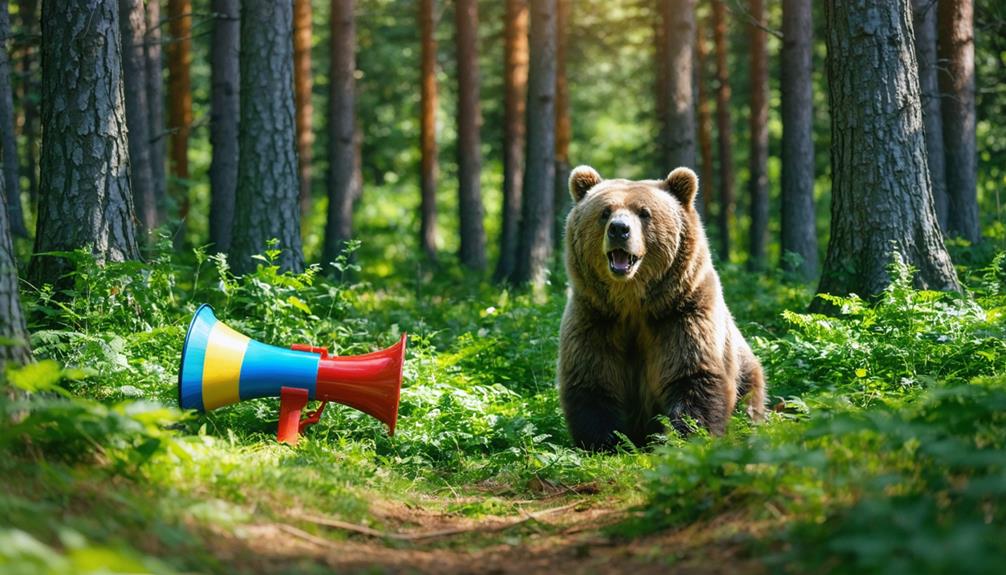
Brainstorm Security Shop

For Orders Over $199

On Any Of Our Products

Details On Refund Page
When you’re out in bear country, you might wonder if an air horn is an effective tool for deterring bears. It’s true that these devices produce loud sounds that can startle wildlife, but understanding the nuances of bear behavior is crucial. You’ll want to consider not just the horn’s volume but also how bears typically react to various stimuli. Are air horns a reliable choice, or do they fall short in real-life encounters? Exploring these questions can reveal a lot about bear interactions and safety strategies.
Understanding bear behavior is crucial for anyone venturing into bear country. Knowing how bears respond to different stimuli can help you stay safe and make informed decisions. Bears are generally cautious and will often avoid humans if they sense your presence. However, their responses can vary widely based on factors like food availability, previous human encounters, and the type of noise you make.
Noise impact plays a significant role in how bears react. Sudden loud noises can startle them, causing them to flee or become defensive. It’s essential to maintain a steady level of sound, like talking or clapping, to alert bears of your presence without overwhelming them. This approach allows you to avoid surprising them, which can lead to aggressive bear responses.
Understanding these behaviors and noise impacts can be vital in preventing dangerous encounters. Always stay alert and be mindful of your surroundings, especially in areas known for bear activity. By respecting their space and understanding their reactions, you can enjoy your time in nature while keeping yourself safe from potential risks.
Air horns are portable devices that create loud, attention-grabbing sounds through a simple mechanism. When you press the button, compressed air rushes out, forcing a diaphragm to vibrate. This vibration produces sound waves that travel through the air.
The sound frequency generated by the air horn typically falls within a range that’s designed to be piercing and easily heard, even over significant distances.
The decibel levels of air horns can reach up to 120 dB or more, making them extremely loud. This level of sound isn’t only startling to humans but can also catch the attention of animals, including bears.
The combination of high sound frequency and intense decibel output is what makes air horns effective in alerting others or deterring wildlife.
Using an air horn is straightforward: just aim it in the desired direction and activate it. The resulting loud blast can serve as a warning, helping you communicate your presence in the wilderness. Remember, though, while air horns are effective, they should be used responsibly to avoid causing unnecessary distress to wildlife.
Research into the effectiveness of air horns in scaring bears has yielded interesting insights. Various scientific studies have examined bear reactions to different noise levels, including that of air horns. In controlled environments, researchers found that bears often displayed signs of distress or avoidance when exposed to the loud, sudden noise generated by air horns. These bear reactions were consistent across various bear species, suggesting a general aversion to such disruptive sounds.
The noise impact of air horns appears to play a crucial role in deterring these animals. In one study, bears exposed to air horn blasts were more likely to flee the area compared to those exposed to quieter stimuli. The intensity and frequency of the noise also matter; louder sounds typically elicit stronger reactions.
While air horns can be effective in certain situations, it’s essential to remember that individual bear responses may vary. Factors like habituation to human presence and environmental conditions can influence how bears react to noise.
Campers often recount their experiences with bears and the effectiveness of air horns in deterring these powerful animals. Many share stories of bear encounters where their trusty air horn played a crucial role. You might hear tales of campers who, upon spotting a bear rummaging through their food stash, quickly grabbed their air horn and blasted it. In these moments, the noise deterrent seemed to startle the bear, prompting it to retreat and leave the area.
Some campers argue that the sheer volume of an air horn is enough to scare off bears, especially if they’re taken by surprise. Others emphasize the importance of using it in conjunction with other safety measures. They suggest that while an air horn can be effective, its success often depends on the specific situation and the bear’s behavior.
While no single method guarantees safety, the anecdotal evidence from campers indicates that air horns can serve as a valuable tool in your bear safety kit. It’s about being prepared and knowing that, in the right moment, a loud blast could make all the difference in your outdoor adventure.
Experts recommend a multi-faceted approach to bear safety, emphasizing that while air horns can be effective, they shouldn’t be your only line of defense. You should combine different strategies to minimize risks and ensure your safety in bear country.
Start by making noise while hiking or camping, as this alerts bears to your presence and reduces surprise encounters. Bear bells, talking, or clapping can help, but be mindful of noise pollution in natural areas. Always stay aware of your surroundings and look for signs of bear activity, like tracks or scat.
In addition to noise-making devices, consider bear spray as a reliable alternative. It’s specifically designed to deter aggressive bears and can be more effective than an air horn in close encounters.
Store food properly, using bear-proof containers, and maintain a clean campsite to avoid attracting bears in the first place.
Absolutely! Air horns can effectively serve as deer deterrents, helping to keep them away from gardens and crops. They’re also useful for bird control, startling birds and preventing them from nesting in unwanted areas.
Air horns can contribute to noise pollution, which might disturb local wildlife. If you’re considering using them, think about the potential impact on the environment and the animals in your area before making a decision.
When you compare noise levels, typical air horns reach around 120 decibels, while chainsaws can exceed 110 decibels. Always take safety precautions—using air horns is crucial when encountering bears to ensure your safety.
Air horns can negatively affect wildlife by altering animal behavior. The loud noise contributes to noise pollution, which may stress animals, disrupt communication, and interfere with natural habitats. You should consider these impacts when using them outdoors.
There aren’t strict age restrictions for using air horns, but consider noise pollution and wildlife conservation. Young users should be supervised to ensure they understand responsible use and respect for the environment around them.
